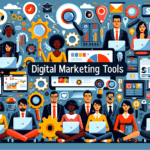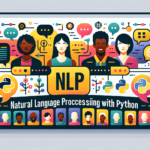Hey, fellow tech enthusiast! Ever wondered how even small businesses these days boast of machine learning capabilities? Well, it’s not just the big tech giants that have access to ML anymore. The democratization of ML is upon us, and it’s named: autoML. Let’s dive in!
Introduction: The Rise of autoML
Machine Learning has grown exponentially over the years. But with its growth came complexity. Enter autoML, the shining knight that made ML accessible even to those without a Ph.D. in data science. Cool, right?
What is autoML?
Alright, picture this: Instead of spending hours, maybe even days, fine-tuning algorithms and selecting features, what if a tool could do it all for you? That’s autoML for you!
The Significance of Automation in ML
Think of autoML as cruise control for machine learning. You set the direction, and it takes over the heavy lifting. By automating repetitive tasks, it ensures that ML models are developed faster and more efficiently.
Demystifying the Core Components of autoML
Have you ever thought of autoML as a master chef in the realm of machine learning? Just like a chef carefully chooses ingredients, prepares them, and cooks to perfection, autoML orchestrates a series of tasks to deliver a stellar machine learning model. But what are these tasks? Let’s deep-dive into the four primary components of autoML that make it a game-changer.
1. Data Preprocessing: The Preparation Phase
What is Data Preprocessing?
Think of raw data as a fresh vegetable. Just like you wouldn’t toss it directly into a salad without washing or chopping, data preprocessing cleans, transforms, and organizes raw data, making it ready for the machine learning feast.
Why is it Vital?
Cleaning the Mess:
Data often comes with missing values, errors, or inconsistencies. Preprocessing ensures that such anomalies are addressed.
Normalization and Standardization:
This adjusts the scales of features, ensuring that one doesn’t overpower another.
Transformation:
Converting data into formats or structures that are more suitable for specific algorithms.
2. Feature Engineering: The Art of Ingredient Selection
What is Feature Engineering?
It’s the process of selecting or creating the most relevant attributes or features that will be fed into our model. Imagine choosing the juiciest tomatoes for a sauce – that’s what feature engineering does with data.
Significance in autoML
Relevance:
Irrelevant or redundant features can derail a model’s accuracy.
New Features:
Sometimes, combining two features or creating new ones can give fresh insights.
Dimensionality Reduction:
Reducing the number of features can simplify the model and reduce computational costs.
3. Model Selection: Picking the Right Recipe
Understanding Model Selection
There are myriad algorithms out there, each with its own strengths and weaknesses. Model selection is like choosing the right recipe for your ingredients.
Why is it Crucial?
Different Data, Different Needs:
Not every algorithm is suitable for every type of data.
Efficiency:
The right model can offer accurate predictions quickly and efficiently.
Avoid Overfitting:
A model too tailored to training data can perform poorly on unseen data. Model selection helps avoid this.
4. Hyperparameter Tuning: Perfecting the Flavor
Decoding Hyperparameter Tuning
Just as a dish might need a pinch more salt or a tad less spice, ML models have parameters that can be adjusted to optimize performance. This fine-tuning process is hyperparameter tuning.
Its Role in autoML
Performance Boost:
Even slight changes in hyperparameters can lead to significantly improved results.
Efficiency:
Automated tuning can find the best parameters faster than manual experiments.
Consistency:
Ensures that the model’s performance is consistent across different datasets and scenarios.
Diving Deep: Top autoML Tools
Automation in machine learning is not just a fleeting trend; it’s a revolution. With the proliferation of autoML tools, harnessing the power of machine learning has never been more accessible. But with numerous options, which ones stand out? Let’s take a detailed look at some of the frontrunners in the autoML arena.
-
Google Cloud AutoML
Overview:
Google Cloud AutoML, stemming from Google’s vast technological prowess, promises an easy and intuitive approach to machine learning. It caters to varying needs, whether you’re analyzing images or crunching numbers in tables.
Key Features:
Tailored Solutions:
From AutoML Vision for image recognition to AutoML Tables for structured data, Google ensures specificity in its offerings.
Data Labelling:
With human reviewers, Google assists in labeling your data, enhancing the model’s accuracy.
Integration:
Seamlessly connects with other Google Cloud services, making data storage, processing, and modeling a coherent process.
-
H2O.ai’s Driverless AI
Overview:
When speed marries efficiency, you get H2O.ai’s Driverless AI. This tool is for those who want to bypass the intricacies of ML modeling without compromising on quality.
Unique Selling Points:
Turbocharged Modeling:
Automated feature engineering, model validation, and deployment are incredibly fast.
Interpretability:
With its machine learning interpretability feature, it demystifies model decisions.
Custom Recipes:
Users can incorporate domain knowledge through Python snippets, ensuring the model aligns with business needs.
-
DataRobot
Overview:
Imagine the collective wisdom of top data scientists embedded in a platform. DataRobot embodies this idea, ensuring that machine learning models are not just automated but also optimal.
What Makes It Shine:
End-to-End Automation:
From data preprocessing to deployment, every stage is automated.
Parallel Processing:
Evaluates multiple models simultaneously, saving time and effort.
Model Explanations:
Understand why and how a model makes decisions, fostering trust in the outcomes.
-
Microsoft Azure’s Automated ML
Overview:
Microsoft, with its extensive cloud ecosystem, brings forth Azure’s Automated ML. It’s a blend of power and simplicity, catering to both ML beginners and veterans.
Standout Features:
Integration Galore:
Fits perfectly within the Azure environment, allowing easy data transfer, processing, and analysis.
Visual Interface:
No code? No problem. Its drag-and-drop interface ensures that even non-programmers can build models.
Guardrails:
Azure’s Automated ML provides best practices and tips, ensuring that users don’t go astray in their ML journey.
Expanding Accessibility to ML
Not everyone can be a data scientist, but with autoML, anyone can harness the power of ML. It’s like giving everyone the power to paint their masterpiece.
Pitfalls and Challenges
However, it’s not all sunshine and rainbows. Relying solely on autoML can lead to generic models. It’s essential to strike a balance, understanding when to let the tool take over and when to intervene.
The Future of autoML
As technology advances, so will autoML. We’re looking at a future where businesses, irrespective of their size, will have ML models tailor-made for their needs without the associated complexities.
Conclusion
The world of autoML is like the gold rush of the tech era. It promises vast riches (read: insights) without the hard labor of traditional mining (read: ML modeling). While it’s essential to understand its capabilities and limitations, one thing’s for sure: autoML is here to stay, and it’s changing the game!
FAQs
What exactly does autoML automate?
From data preprocessing to hyperparameter tuning, autoML automates the entire ML workflow.
Do I need to know coding to use autoML tools?
Most autoML tools are designed to be user-friendly, requiring minimal coding knowledge. So, you’re good to go!




